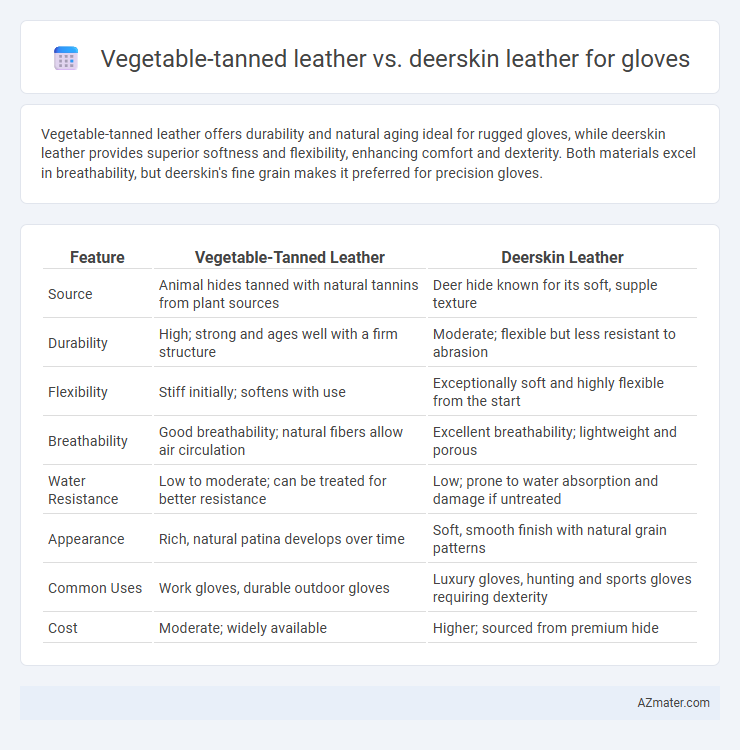Vegetable-tanned leather offers durability and natural aging ideal for rugged gloves, while deerskin leather provides superior softness and flexibility, enhancing comfort and dexterity. Both materials excel in breathability, but deerskin's fine grain makes it preferred for precision gloves.
Table of Comparison
| Feature | Vegetable-Tanned Leather | Deerskin Leather |
|---|---|---|
| Source | Animal hides tanned with natural tannins from plant sources | Deer hide known for its soft, supple texture |
| Durability | High; strong and ages well with a firm structure | Moderate; flexible but less resistant to abrasion |
| Flexibility | Stiff initially; softens with use | Exceptionally soft and highly flexible from the start |
| Breathability | Good breathability; natural fibers allow air circulation | Excellent breathability; lightweight and porous |
| Water Resistance | Low to moderate; can be treated for better resistance | Low; prone to water absorption and damage if untreated |
| Appearance | Rich, natural patina develops over time | Soft, smooth finish with natural grain patterns |
| Common Uses | Work gloves, durable outdoor gloves | Luxury gloves, hunting and sports gloves requiring dexterity |
| Cost | Moderate; widely available | Higher; sourced from premium hide |
Introduction to Glove Leather Types
Vegetable-tanned leather and deerskin leather are two prominent materials used in glove manufacturing, each offering distinct characteristics. Vegetable-tanned leather is known for its durability, firm structure, and rich patina development over time, making it ideal for work gloves and formal wear. Deerskin leather provides exceptional softness, flexibility, and natural water resistance, perfect for gloves requiring comfort and dexterity, such as hunting or driving gloves.
What is Vegetable-Tanned Leather?
Vegetable-tanned leather is crafted using natural tannins extracted from tree bark, leaves, and other plant materials, resulting in a durable and eco-friendly material ideal for gloves. This tanning method enhances breathability and develops a rich patina over time, providing both comfort and aesthetic appeal for deerskin glove designs. Compared to deerskin leather, vegetable-tanned leather offers greater customization in thickness and stiffness, making it suitable for protective and dress gloves alike.
What is Deerskin Leather?
Deerskin leather, known for its exceptional softness and natural elasticity, is derived from deer hides, making it highly breathable and durable compared to other types of leather like vegetable-tanned leather. Its fine grain and pliability provide superior flexibility and comfort, ideal for gloves requiring sensitive tactile feedback and long-lasting wear. Unlike vegetable-tanned leather, deerskin leather undergoes a specialized tanning process preserving its natural oils, enhancing moisture resistance and softness essential for premium glove craftsmanship.
Key Differences in Leather Sourcing
Vegetable-tanned leather is sourced from cattle hides processed using natural tannins extracted from tree bark and plant materials, resulting in a durable, eco-friendly material that ages with a rich patina. Deerskin leather is derived from the hides of deer, offering a softer, more supple texture due to its finer grain and thinner hide, often harvested from wild or farmed deer in North America. The sourcing of vegetable-tanned leather emphasizes sustainable and chemical-free methods, whereas deerskin leather sourcing is influenced by hunting regulations and wild animal populations, impacting availability and ethical considerations.
Comparative Durability and Strength
Vegetable-tanned leather offers high durability due to its firm, dense fibers and natural tanning process, making it resistant to wear and tear over time. Deerskin leather, while softer and more flexible, provides excellent tensile strength and abrasion resistance, especially in wet conditions, but may not match the long-term firmness of vegetable-tanned leather. For gloves requiring a balance of durability and strength, vegetable-tanned leather excels in structural resilience, whereas deerskin leather is preferred for superior flexibility and toughness in dynamic use.
Comfort and Flexibility in Gloves
Vegetable-tanned leather offers superior breathability and molds naturally to the hand over time, providing increasing comfort during extended wear. Deerskin leather is renowned for its exceptional softness and high flexibility, allowing for enhanced dexterity and a close fit in gloves. Both materials excel in comfort, but deerskin's pliability makes it particularly suited for gloves requiring fine motor control.
Aesthetic Qualities and Aging
Vegetable-tanned leather offers a rich, natural patina that deepens with age, showcasing warm hues and subtle texture variations ideal for gloves that develop character over time. Deerskin leather, known for its supple, smooth grain and lighter color, maintains a soft, flexible feel but tends to develop gentle wear marks rather than a pronounced patina. Both leathers provide distinct aesthetic qualities, with vegetable-tanned leather emphasizing rugged, evolving beauty and deerskin focusing on enduring softness and subtle aging effects.
Breathability and Moisture Management
Vegetable-tanned leather offers excellent breathability due to its natural tanning process, allowing air to circulate and moisture to evaporate, which keeps gloves dry and comfortable during extended use. Deerskin leather, known for its soft grain and porous texture, provides superior moisture management by absorbing sweat and releasing it quickly, reducing clamminess inside the glove. Both materials excel in thermal regulation, but vegetable-tanned leather is typically preferred for long-term breathability, while deerskin gloves offer enhanced flexibility and moisture wicking for active wear.
Sustainability and Environmental Impact
Vegetable-tanned leather uses natural tannins from plant sources, significantly reducing chemical pollution and enhancing biodegradability compared to chrome-tanned alternatives. Deerskin leather, often sourced from wild or farmed deer, can be sustainable when obtained as a byproduct of meat production, minimizing waste. Both materials offer eco-friendly options for gloves, with vegetable-tanned leather excelling in low-toxicity processing and deerskin providing a renewable resource with excellent durability and biodegradability.
Choosing the Right Leather for Your Gloves
Vegetable-tanned leather offers durability and natural resistance, making it ideal for heavy-duty gloves requiring structure and longevity, while deerskin leather provides superior softness, flexibility, and breathability, perfect for gloves prioritizing comfort and dexterity. When choosing the right leather for gloves, consider the application: vegetable-tanned gloves excel in rugged environments, whereas deerskin gloves enhance tactile sensitivity and fit. Assess factors such as wear resistance, maintenance, and comfort to select leather that aligns with your glove usage and performance needs.

Infographic: Vegetable-tanned leather vs Deerskin leather for Glove
 azmater.com
azmater.com